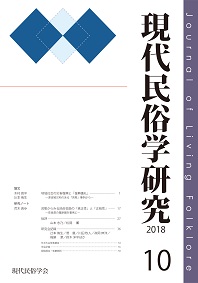『現代民俗学研究』について > 第10号目次および論文要旨
第10号(2018年3月付) 60頁
・『現代民俗学研究』第10号は2018年4月より頒布開始しました。
目次
論文
木村 周平・辻本 侑生 地域社会の災害復興と「復興儀礼」―津波被災地のある「失敗」事例から―
研究ノート
荒木 真歩 芸態からみる民俗芸能の「真正性」と「正統性」―奈良県の篠原踊を事例に―
批評
山本 志乃 / 松岡 薫
研究会記録/学会記録/年次大会発表要旨
木村周平・辻本侑生 KIMURA Shuhei, Tsujimoto Yuki
pp. 1-16.
地域社会の災害復興と「復興儀礼」―津波被災地のある「失敗」事例から―
Community disaster recovery and “Recovery Ritual”A case study of a “failed” ritual in a tsunami-affected community
キーワード:災害復興 復興儀礼 五年祭 三陸町綾里
要旨
災害からの復興に向けた営為が重要であることについては誰もが理解しているが、ではどのようにして復興が達成されたと言えるのかについて十分な合意を得ることは難しい。とくに近年では、インフラなどのハード面だけでなく、文化や社会の側面からのアプローチの重要性が指摘されている。2011年3月11日に東日本大震災が発生した後、まだ日常生活が戻っていないなかで、被災した人々がいちはやく伝統芸能を演じたり、祭礼を普段通りに行ったりしたことはよく知られているが、こうした被災地での動きは、災害復興の象徴的な側面を探究する必要性を示している。この点について、社会学者の山泰幸は、復興を進めるうえでの儀礼の役割に注目し、「復興儀礼」という概念を提示している。本論文は、山の「復興儀礼」概念を導きの糸に、大船渡市のある地区で2016年に行われた五年祭を検討する。この儀礼は一部の人々から「ホントではない」と言われ、地域の人々の間で「復興感」を醸成するのに失敗したかのように見える。だが本論文では、この「失敗」の背景と帰結を丹念に追うことで、地域社会がいわゆる災害復興とは異なるかたちで再生しようとする活力や創造力を見いだす。そして、儀礼を手がかりに、その実施への具体的なプロセスのなかで浮かび上がる人々のまとまりを辿り、彼らの創造性を支えていくことが、地域社会のこれからにつながるのではないか、と主張する。
Abstract
While everyone knows the importance of the efforts for disaster recovery, there is little consensus about when and how it is achieved. After the tsunami of March 11, 2011, we witnessed that, even when their life had never returned to normal, affected people attempted to perform traditional arts as soon as possible, or conduct their traditional rituals as usual. Their struggle urges us to explore the symbolic aspect of disaster recovery. Among others sociologist Yasuyuki Yama maintains that ritual can play a crucial role to help the victims to realize the progress of recovery. Introducing Yama’s seminal concept of “recovery ritual,” this article examines an “inauthentic” quinquennial ritual (gonensai) conducted in 2016 at a tsunami-affected community in Ofunato City, Iwate Prefecture. It was “inauthentic” since it was not carried out as planned, and thus it appeared to fail to foster a sense of recovery among the community members. Tracing the background to the “failure” and its consequences in detail, we read a sign of vitality and creativity of the community in it, which would “recover” the community in a different way from disaster reconstruction (fukko). While the importance to support to stage rituals is never lost, we suggest, ritual can be a window to find a way to support the resilience of the everyday community life of the affected people.
荒木真歩 ARAKI Maho
pp. 17-26.
芸態からみる民俗芸能の「真正性」と「正統性」 ―奈良県の篠原踊を事例に―
Authenticity and Legitimacy of Folk Performing Arts A Case Study of Shinohara-Odori in Nara, Japan
キーワード:民俗芸能 芸態変化 真正性 正統性 文化財行政
要旨
本稿は、現代の民俗芸能の伝承現場において、芸態の変化に着目し、伝承組織の再編による芸態の「真正性」と「正統性」について検討するものである。芸態の「真正性」とは特に文化財行政が保存したいと考えるような古老が演じる一番古い芸態であり、芸態の「正統性」とは伝承組織や周辺環境の社会背景などの理由により、伝承組織の中で今後伝承すべきと考えられている芸態のことを指す。今回事例とする篠原踊りは、2014年より奈良県の文化財行政によって奈良県内外から世代や背景が異なる伝承者を公募し「篠原おどり保存会」として再編した。伝承の過程で起こった芸態変化をみてゆくと、篠原踊りはこの再編により従来の芸態の「真正性=正統性」という図式は崩れ、「真正」な芸態は古老が演じ文化財行政が支持したものであり、「正統」な芸態は古老よりも時代が下り省略した芸態であるが、篠原踊りで代々リーダー格であった家系の伝承者の芸態であり、この後者の芸態がたの伝承者に選ばれ、伝承されることを明らかにした。
Abstract
The purpose of this paper is to uncover older successors of folk performing arts think as authentic art forms and what other successors chose to pass down as legitimate art form. The propositions of this paper are based on the study of folk performing art known as Shinohara-Odori from the Shinohara Village, in Nara, Japan. In 2015, Shinohara-Odori was reorganized by the administration of cultural properties as a preservation project. The thesis of this analysis is that a strong family line greatly influences which changes are incorporated into traditional art forms in Shinohara-Odori. In conclusion the Shinohara-Odori preservation society abide by the strength of family lines in choosing what to pass down in their art form. In the past, successors thought that an authentic art form was based on the knowledge of performers, but recently new group of successors that try to preserve traditional art form think that orthodoxy is based on the influence of a strong family line in folk performing arts.